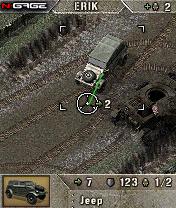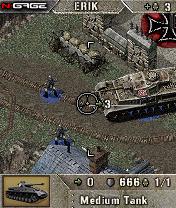Pathway to Glory Hands-On Preview
We take an extended hands-on tour of Nokia's upcoming WWII turn-based strategy game.
The latest preview build of Pathway to Glory, Nokia's huge WWII turn-based strategy game, offers only one playable single-player level and a lone multiplayer map. However, even this tiny demonstration was enough to make it clear that Pathway is evolving into what will likely be the best mobile action/strategy game ever made. Nokia has made a number of subtle changes to Pathway's gameplay mix that add depth to an already detail-laden game, even while maintaining the playability level necessary to make such a complicated experience feasible for the N-Gage. This preview build of Pathway also provides some fresh insight into how Nokia is positioning the game's inventory and character development systems to maximize strategic flexibility and replay value.

The sample single-player level provided with this build of Pathway covers an American mission on Pantelleria, a North African islet guarded by Italian troops. Before the expedition begins, you have the opportunity to type in your name as well as to choose your squad's nationality and insignia. Six squad symbols are available in the preview, including a four-leafed clover, an eagle, and angel wings. American is the only selectable nationality at this point, but other grayed-out Allied countries such as Britain, Canada, France, and Australia are visible in the nationality menu. After making these choices, you are treated to a faux newsreel montage of images to set the stage for Pantelleria, complete with arrowed maps, a stentorian radio announcer's voice-over, and a briefing from a stern commanding officer, who orders your commando squad to take out the island's water tank in advance of an invasion. A black-and-white level map is provided to give you an idea of where your insertion point is relative to your objective.
The final step before taking action is to choose your squad members, from a collection of different specialists, and outfit them in a manner appropriate to your overall style of play. Soldiers can specialize in a number of different areas: there are heavy-weapons experts, who are the best with bazookas; medics, who can use medical kits to patch up wounded comrades; rangers, who have very strong general combat skills; and radiomen, who can call in air strikes with a turn's notice. The final version of the game will also include snipers, who can assassinate enemies from far away. By pressing the pound button on the keypad while simultaneously highlighting a soldier in the squad-picking menu, you can gain access to the soldier information screen, which provides data on a particular grunt's specs. This information is surprisingly comprehensive, and it includes the soldier's branch of service, rank, combat statistics (such as number of enemies killed and accuracy rates with different types of weapons), and skill levels with said weapons. You can even find out a soldier's date of birth and the place where he was born, as well as access high-resolution portraits featuring the warrior in full battle regalia. According to Nokia, soldiers' abilities will change as they gain experience, kills, and promotions. It's impossible to determine the extent of this evolution over the course of a full campaign in the abbreviated version we played, but we noticed that particularly successful soldiers did indeed receive higher ranks at the end of the single-player mission. Equipping your band of brothers also plays a large role in Pathway: Depending on the mission and your soldiers' abilities, you have your pick from a large array of accoutrement, including rifles, pistols, sub machine guns, various types of grenades, antitank missiles, medkits, and radios. You can keep burdening soldiers with equipment if you like, but every weight increase drops their available action points precipitously during combat.
Pathway's gameplay has grown more nuanced since the last playable build. The most interesting additions focus on an individual soldier's combat stance and aim, which allows you to micromanage combat to a much greater extent. For example, you can now order a particular soldier to lie prone, kneel, or stand, using the "8" and "0" keys. Soldiers in lower stances receive aiming bonuses and they are much harder for enemies to hit, but they take a great deal more action points to move around. More conservative positions also increase the range of a soldier's line of sight--but at the cost of diminishing the angle of his viewpoint (in other words, your soldier will be able to see a little further during the enemy's turn, but his peripheral vision will decrease). The new version of Pathway has also increased your control over the aiming process. When a highlighted soldier clicks on an enemy, a colored aiming reticle pops up, telling you how likely it is that your shot will succeed (colors range from fish-in-a-barrel green to don't-waste-your-ammo red). However, depending upon the distance to the target, you can choose to increase or decrease the amount of action points used for the shot to adjust your chances. For example, if you've crept up on an enemy soldier and have an easy shot, it's better to dial your aim down to a snap shot and conserve action points; but if you're sniping someone from long range, it pays dividends to put in eight action points for a careful shot. This intuitive system helps to tailor your fighting style to the situation and adds a lot of realism to the combat experience.

Pathway to Glory's vaunted multiplayer features are still incomplete at the time of this writing, but the nascent multiplayer functionality included in the preview indicates that Nokia is well on its way to turning its marketing slogan for Pathway, "Global Warfare," into reality. This version includes support for a two-person match on a single multiplayer map using Bluetooth or the pass-and-play "hotseat" mode. Pathway to Glory's turn-based gameplay is a natural fit for multiplayer; each player receives a set amount of time for his turn (generally around a minute), adding to the importance of careful planning and fast execution. The final game will also include support for four-way cooperative missions. Most importantly, the game will also support multiplayer battles over N-Gage Arena, which will take place on 12 unique multiplayer maps spanning four campaigns, according to information provided in the preview.
We hope that Nokia can make multiplayer over Arena work consistently in the retail version. If it can deliver the first interactive Arena multiplayer experience for N-Gage in the guise of Pathway's superior design, it will surely be the platform's first killer application (even if it can't be done, the game looks as though it will still be uniquely enthralling). This preview build is in need of some minor tuning: The game's frame rate chokes a little when scrolling quickly from one side of a map to the other, for instance, and the grenade-tossing mechanics are clearly unfinished. Nevertheless, Pathway to Glory is shaping up to be everything Nokia has promised, even down to the absurd number of spoken languages in the game: The preview features clearly audible snippets of English, German, and Italian as soldiers move around and respond to orders.
Pathway to Glory is already a mobile game you can get lost in, even with only a single playable level. GameSpot will have the full review as soon as the final version comes out in a few months.
Got a news tip or want to contact us directly? Email news@gamespot.com
Join the conversation